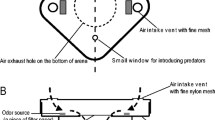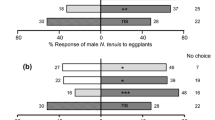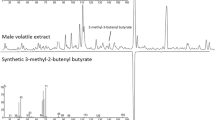Abstract
TheMaladera matrida beetle (Coleoptera, Scarabaeidae, Melolonthinae), a relatively new species to science, was first identified in Israel in 1983. In the course of field observations it was found that adultM. matrida beetles emerged from the soil at sunset to feed and mate. During the first 20 min of flight, most of the beetles were males. The females emerged shortly afterwards, and aggregations numbering 20–30 individuals with equal proportions of males and females were eventually formed on peanut plants. Laboratory olfactometer bioassays showed that peanut leaves (food) attracted both males and females. Field-trapping experiments and olfactometer studies showed thatM. matrida beetles were highly attracted by live virgin females in the presence of food (cut-up peanut leaves). Another set of field trapping experiments indicated that airborne volatiles produced by live virgin females plus food had the same attracting ability as live virgin females plus food. The attraction exerted by the combination of live virgin females and peanut leave volatiles suggests a synergism effect. Accordingly, we propose a two-stage mechanism of chemical communication in theM. matrida beetles: first, the males cause mechanical damage to the host plant to attract both sexes; later, the females emit attractants (sex pheromone) while eating or shortly thereafter.
Similar content being viewed by others
References
Argaman, Q. 1986.Maladera matrida, a new Scarabaeidae in Israel.Shapirit 4:40–46. (In Hebrew), 47–48 (English summary).
Argaman, Q. 1990. Redescription ofMaladera matrida (Coleoptera, Scarabaeidae, Melolonthinae).Isr. J. Entomol. 24:21–27.
Bartelt, R.J., Seaton, K.L., andDowd, P.F. 1993. Aggregation pheromone ofCarpophilus antiquus (Coleoptera: Scarabaeidae) and kairomonal use ofC. lugubris pheromone byC. antiquus.J. Chem. Ecol. 19:2203–2216.
Bestmann, H.J., andVostrowsky, O. 1988. Pheromones of the Coleoptera, pp. 95–183,in E.D. Morgan and N.B. Mandava (eds.). CRC Handbook of Natural Pesticides, Vol. 4, part A. CRC Press, Boca Raton, Florida.
Campbell, C.A.M., Pettersson, J., Pickett, J.A., Wadhams, L.J., andWoodcock, C.M. 1993. Spring migration of Damson-hop aphid,Phorodon humuli (Homoptera, Aphididae), and summer host plant-derived semiochemicals released on feeding.J. Chem. Ecol. 19:1569–1576.
Domek, J.M., andJohnson, D.T. 1987. Evidence of a sex pheromone in the green June beetle,Cotinis nitida (L) (Coleoptera: Scarabaeidae).J. Entomol. Sci. 22:264–267.
Domek, J.M., andJohnson, D.T. 1988. Demonstration of semiochemically induced aggregation in the green June beetle,Cotinis nitida (L) (Coleoptera: Scarabaeidae).Environm. Entomol. 17:147–149.
Domek, J.M., Tumlinson, J.H., andJohnson, D.T. 1990. Responses of male green June beetlesContinis nitida (L) (Coleoptera: Scarabaeidae) to female volatiles in a flight tunnel.J. Insect Behav. 3:271–276.
Gaston, L.K. 1984. Techniques and equipment for collection of volatile chemicals from individual, natural, or artificial sources, pp. 217–222,in H. Hummel and T.A. Miller (eds.). Techniques in Pheromone Research. Springer-Verlag, New York.
Gerling, D., andHefez, A. 1990. The ecology of theMaladera beetle.In R&D for Pest Management ofMaladera. Israel Ministry of Agriculture (in Hebrew).
Golberg, A.M., Gamliel, B., Wolfovich, M., Sando, T., andAlmogi-Labin, A. 1986. Preliminary observations on the biology ofMaladera sp.Phytoparasitica 14:156–157 (abstract).
Gol'berg, A.M., Yathom, S., Almogi-Labin, A., andFridlad-Wunder, G. 1989. Diurnal and seasonal occurrence, feeding habits and mating behavior ofMaladera matrida adults in Israel.Phytoparasitica 17:81–89.
Golub, M.A., andWeatherston, I. 1984. Techniques for extracting and collecting sex pheromones from live insects and from artificial sources, pp. 223–286,in H. Hummel, and T.A. Miller (eds.). Techniques in Pheromone Research. Springer-Verlag, New York.
Harari, A., Ben-Yakir, D., andRosen, D. 1994. Mechanisms of aggregation behavior inMaladera matrida Argaman (Coleoptera: Scarabaeidae).J. Chem. Ecol. 20:361–371.
Heath, R.R., andManukian, A. 1992. Development and evaluation of systems to collect volatile semiochemicals from insects and plants using a charcoal-infused medium for air purification.J. Chem. Ecol. 17:1209–1226.
Henzell, R.F., andLowe, M.D. 1970. Sex attractant of the grass grub beetle.Science 168:1005–1006.
Jursik, T., Stransky, K., andUbik, K. 1990. Trapping system for trace organic volatiles. Proceedings, Conference on Insect Chemical Ecology, Tabor, Academia Prague and SPB Acad. Publ. 327–330.
Klein, M.G., Tumlinson, J.H., Ladd, T.L., Jr., andDoolittle, R.E. 1981. Japanese beetle (Coleoptera: Scarabaeidae) response to synthetic sex attractant plus phenethyl propionate: Eugenol.J. Chem. Ecol. 7:1–7.
Klein, Z.I., andChen, C. 1983. Interception and introduction of new pests in Israel.Phytoparasitica 11:124 (abstract).
Ladd, T.L., Klein, M.G., andTumlinson, J.H. 1981. Phenethyl propionate + eugenol + geraniol (3:7:3) and japonilure: A highly effective joint lure for Japanese beetles.J. Econ. Entomol. 74:665–667.
Leal, W.S., Mochizuki, F., Wakamura, S., andYasuda, T. 1992. Electroantennographic detection ofAnomala cupera Hope (Coleoptera: Scarabaeidae) sex pheromone.Appl. Entomol. Zool. 27:289–291.
Leal, W.S., Sawada, M., andHasegawa, M. 1993. The scarab bettleAnomala cupera utilizes the sex pheromone ofPopillia japonica as a minor component.J. Chem. Ecol. 19:1303–1313.
Shani, A., andLacey, M.J. 1984. Convenient method applicable to single insects for collection and measurements of blend ratios of airborne pheromones from artificial sources.J. Chem. Ecol. 10:1677–1692.
Sokal, R.R., andRohlf, F.J. 1981. Biometry. W.H. Freeman. San Francisco.
Tamaki, Y., Sugie, H., andNoguchi, H. 1985. Methyl (Z)-5-tetradecenoate: Sex attractant pheromone of the soybean beetle,Anomala rufocupera Motschulsky (Coleoptera: Scarabaeidae).Appl. Entomol. Zool. 20:359–361.
Tumlinson, J.H., Klein, M.G., Doolittle, R.E., Ladd, T.L., andProveaux, A.T. 1977. Identification of the female Japanese beetle sex pheromone: Inhibition of male response by an enantiomer.Science 197:789–792.
Weissling, T.J., Giblin-Davis, R.M., andScheffrahn, R.H. 1993. Laboratory and field evidence for male-produced aggregation pheromone inRhynchophorus cruentatus (F) (Coleoptera: Scarabaeidae).J. Chem. Ecol. 19:1195–1203.
Author information
Authors and Affiliations
Rights and permissions
About this article
Cite this article
Yarden, G., Shani, A. Evidence for volatile chemical attractants in the beetleMaladera matrida argaman (Coleoptera: Scarabaeidae). J Chem Ecol 20, 2673–2685 (1994). https://doi.org/10.1007/BF02036200
Received:
Accepted:
Issue Date:
DOI: https://doi.org/10.1007/BF02036200




